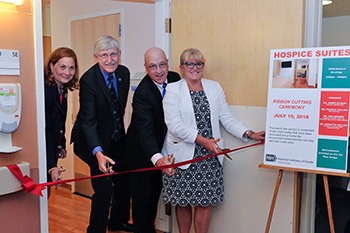News Briefs
NIH Clinical Center Opens Hospice Unit

PHOTO BY: MARLEEN VAN DEN NESTE
The Clinical Center’s new hospice unit cared for its first patient six days after its July 10, 2018, opening. Pictured (from left), Chief of Pain and Palliative Care Ann Berger, NIH Director Francis Collins, Clinical Center CEO James Gilman, and Chief Nurse Officer Gwen Wallen.
“Amazing efforts that go on here at the NIH Clinical Center [help] people for whom medicine basically doesn’t have any answers and where the best kind of science is brought to bear, oftentimes for people who are very seriously ill,” said NIH Director Francis Collins at the opening of the NIH Clinical Center’s (CC’s) first hospice unit on July 10, 2018. But not all efforts result in happy outcomes. “We owe it to [our patients] in those circumstances where our best efforts are not succeeding to care for them in a place like this [hospice unit] to provide them with that kind of dignified, loving surrounding while making it possible for them to be with their families in these final moments.”
Six days after the hospice unit opened, it cared for its first patient, a man who had been on a clinical protocol to treat his cancer for several months. His condition had worsened and he was admitted to the intensive care unit (ICU). After a few days, it was determined that he could not be stabilized so he was moved to the hospice unit. Eleven hours later, he passed away with his family by his side.
The patient’s family “was very pleased that they could have meals together as a family and be with their loved one in a homelike environment,” said Ann Berger, chief of the CC’s Palliative Care service.
Hospice is a philosophy of care in which terminally ill patients and their families are provided comfort and a place to be together at the end of life. Families often want to be with their loved one in an environment that is more family-friendly than an ICU. The NIH hospice unit comprises two suites, each of which has a bedroom and a community room equipped with a kitchen and family sitting area.
About 10,000 new patients a year are treated at the CC, the world’s largest hospital devoted exclusively to clinical investigation. Although most people taking part in clinical research have good outcomes, about 50 die each year at the CC. In the past, they have passed away in various units or have gone home or to hospice units elsewhere.
Berger, who was instrumental in developing the hospice unit, believes that the CC is unique in the excellent care it provides when treating patients and says that the NIH can be the best of the best in end-of-life care as well. Compassion and empathy are always important in medical care, but are especially important during the end of life because this period of time will always be remembered by the patient’s family, she said.
The 16 nurses who have been trained to work in the new unit have taken an end-of-life course, spent time at Montgomery Hospice (Rockville, Maryland), and then worked in the CC’s palliative-care service, which provides skilled management of symptoms and allays psychosocial, emotional, and spiritual suffering.
“We will be training more nurses on other units so that end-of-life care is improved throughout the Clinical Center, not only in the hospice unit,” said Berger. “Because of the unit, nursing standards of practice for end-of-life care have been written for the whole Clinical Center.”
CC Chief Nurse Officer Gwen Wallen explained how important it is to make sure that hospice units are high-touch not high-tech. “Our nursing staff are highly invested in providing this ‘high-touch’ environment for patients at the end-of-life as well as to their families,” she said. “We’re going to have to work as interdisciplinary teams to make [the hospice unit] work the way it’s supposed to work and so that Ann’s team [can] fulfill this high-touch, low-tech area in a clinical-research environment.”
“People come [to the NIH] and hope for a cure for their illness,” said Berger. “That is not always possible, but with excellent end-of-life care we can help both the patient and family heal” psychologically and spiritually.
U.S. Public Health Service Flag at NIH

PHOTO BY: ERNIE BRANSON, NIH
The U.S. Public Health Service traces its roots to July 16, 1798, when President John Adams signed into law the “Act for the Relief of Sick and Disabled Seaman.” On July 16, 2018, the U.S. Public Health Service flag was raised on the main flagpole outside Building One to commemorate 220 years of protecting, promoting, and advancing the health and safety of our nation. The celebration featured keynote remarks from Assistant Secretary for Health Admiral Brett P. Goroir, and talks by senior NIH and Commissioned Corps leadership. The flag will be at NIH permanently.

CREDIT: NIK01AY, THINKSTOCK.COM
This page was last updated on Wednesday, April 6, 2022
